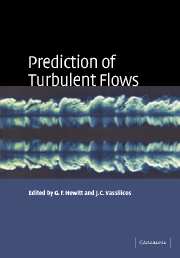Book contents
- Frontmatter
- Contents
- 1 Introduction
- 2 Developments in the understanding and modelling of turbulence
- 3 RANS modelling of turbulent flows affected by buoyancy or stratification
- 4 Turbulent flames
- 5 Boundary layers under strong distortion: an experimentalist's view
- 6 Turbulence simulation
- 7 Computational modelling of multi-phase flows
- 8 Guidelines and criteria for the use of turbulence models in complex flows
8 - Guidelines and criteria for the use of turbulence models in complex flows
Published online by Cambridge University Press: 12 August 2009
- Frontmatter
- Contents
- 1 Introduction
- 2 Developments in the understanding and modelling of turbulence
- 3 RANS modelling of turbulent flows affected by buoyancy or stratification
- 4 Turbulent flames
- 5 Boundary layers under strong distortion: an experimentalist's view
- 6 Turbulence simulation
- 7 Computational modelling of multi-phase flows
- 8 Guidelines and criteria for the use of turbulence models in complex flows
Summary
Summary
This chapter begins with a review of the principles underlying general purpose turbulence models and the assumptions and procedures involved in applying them to calculate the kind of complex flows that are analysed in practical engineering and environmental problems. Secondly we develop, from considerations of basic mechanisms of turbulence and the different types of statistical turbulence model, a new guideline ‘map’ based on characteristic statistical parameters, which can be derived from standard models. This indicates in principle which types of turbulent flow can and cannot be approximately calculated with the current generation of ‘CFD’, one-point turbulence models, including those using k–ε and second order closure equations. No attempt is made to identify any one optimum model scheme. Thirdly, the proposed guidelines for the likely accuracy of turbulent modelling are tested by comparing them with the results of previous test-case studies for a range of complex turbulent flows, where standard models fail or need special adaptation. These include thermal convection, free stream turbulence, aeronautical flows and flows round bluff bodies. The relative merits of advanced models (e.g. involving two-point statistics) and numerical simulations are also discussed, but the CFD practitioner should note that the emphasis here is on why current models will not work in all circumstances. The technical level of this chapter is most suitable for readers with some formal training in fluid dynamics. These general guidelines are complementary to user guidelines for computational fluid dynamics codes.
- Type
- Chapter
- Information
- Prediction of Turbulent Flows , pp. 291 - 343Publisher: Cambridge University PressPrint publication year: 2005
- 7
- Cited by

